Microsoft Dynamics 365 Customer Insights - Journeys messaging
Microsoft Dynamics 365 Customer Insights - Journeys, integrated with Infobip, offers robust messaging capabilities across SMS, RCS, WhatsApp, and Viber.
SMS messaging offers:
- Direct Communication: Reach customers instantly on mobile devices
- Personalization: Use customer-specific data for tailored messages
- Inbound Messaging: Trigger journeys based on customer replies
- Real-Time Analytics: Track delivery and engagement for campaign insights
WhatsApp and Viber messaging offers:
- Rich Media Support: Send images, videos, and clickable links
- Trigger-Based Journeys: Automate interactions based on customer actions
- Failover Mechanism: Switch to SMS if primary channels fail
- Unified Templates: Maintain consistency across channels
The benefits of using the integration with Microsoft Dynamics 365 Customer Insights - Journeys are:
- Enhance customer engagement with multi-channel communication
- Simplify operations with a single interface for all messaging needs
What you will need
Before you start, you will need:
- Your Infobip account. If you do not have an Infobip account, you can create one (opens in a new tab)
- Microsoft Dynamics 365 account with the Customer Insights solution
- Infobip Messaging Admin or Infobip Messaging User Marketing security role in Dynamics to access and configure the app.
For more information on configuration, see the Dynamics 365 Customer Insights - Journeys documentation (opens in a new tab).
SMS configuration
The SMS channel is available natively in the Customer Insights – Journeys. To configure the SMS channel connection to Infobip, see the user guide from Microsoft (opens in a new tab).
WhatsApp, RCS, Viber – app installation
The Microsoft Dynamics 365 Insights app is built in Power Apps and is available for an easy installation on the AppSource marketplace. To install the app:
- Go to the AppSource listing Messaging for Dynamics 365 Customer Insights (opens in a new tab) and click on Get it now.
- Select the environment where the Customer Insights solution is deployed.
- Wait until the installation is completed.
Configuration
In Dynamics 365, go to Apps and open the Dynamics 365 link. Then, select Infobip Messaging.

To configure the app, use the following steps:
Step 1 - Give Consent
- Go to Settings and click Give Consent.
- Use an account with System Administrator privilege to get permissions.
Step 2 - API Credentials
- Go to Settings and then go to API Credentials.
- Click New.
- On the General tab, add the following information:
- Insert the name of the configuration.
- Insert the API Key that you received from Infobip.
- Click Save.
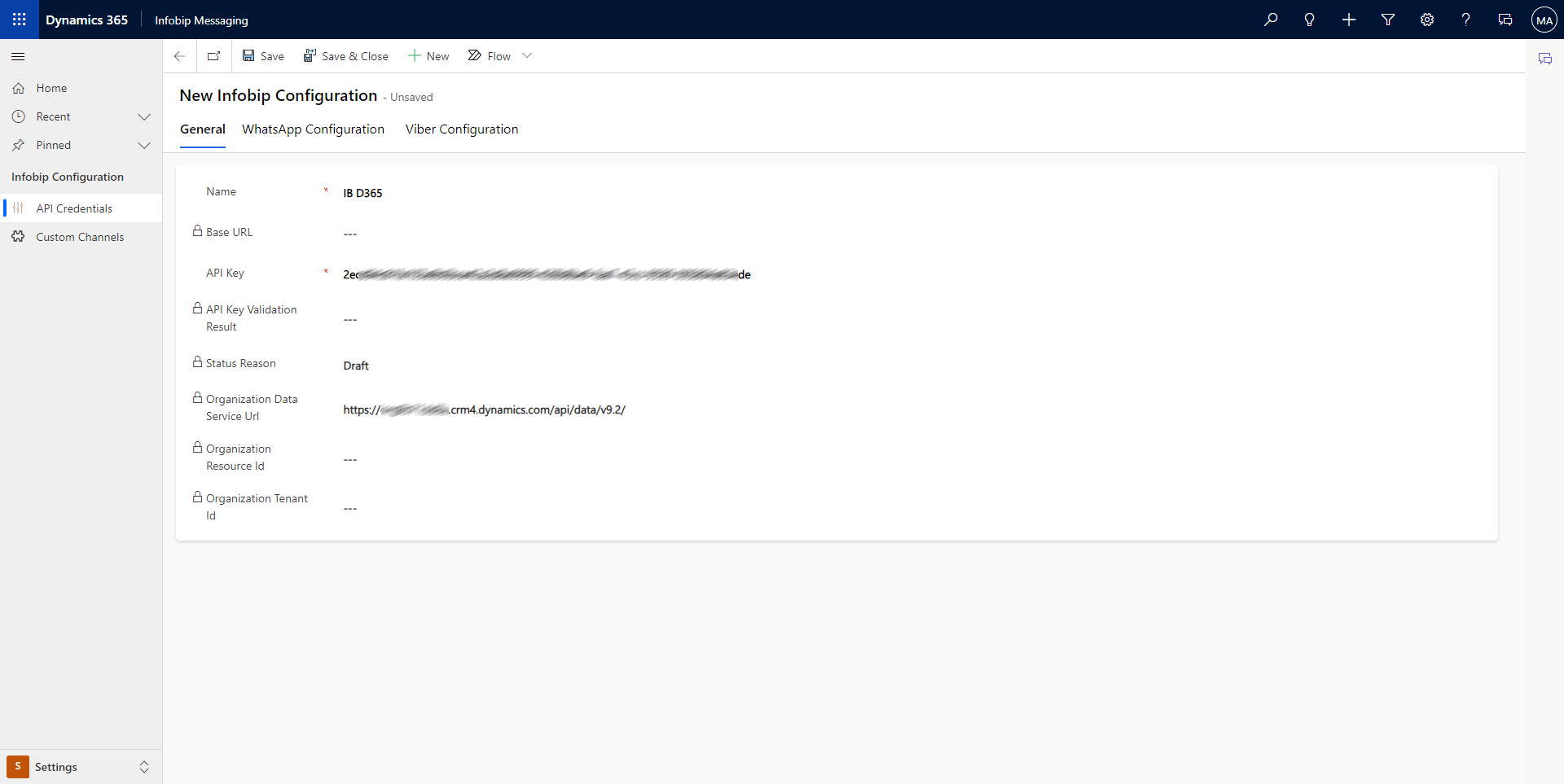
Step 3 - Set as live
- Share the Organization Data Service Url with Infobip to register for sending reports.
- Click Set As Live.
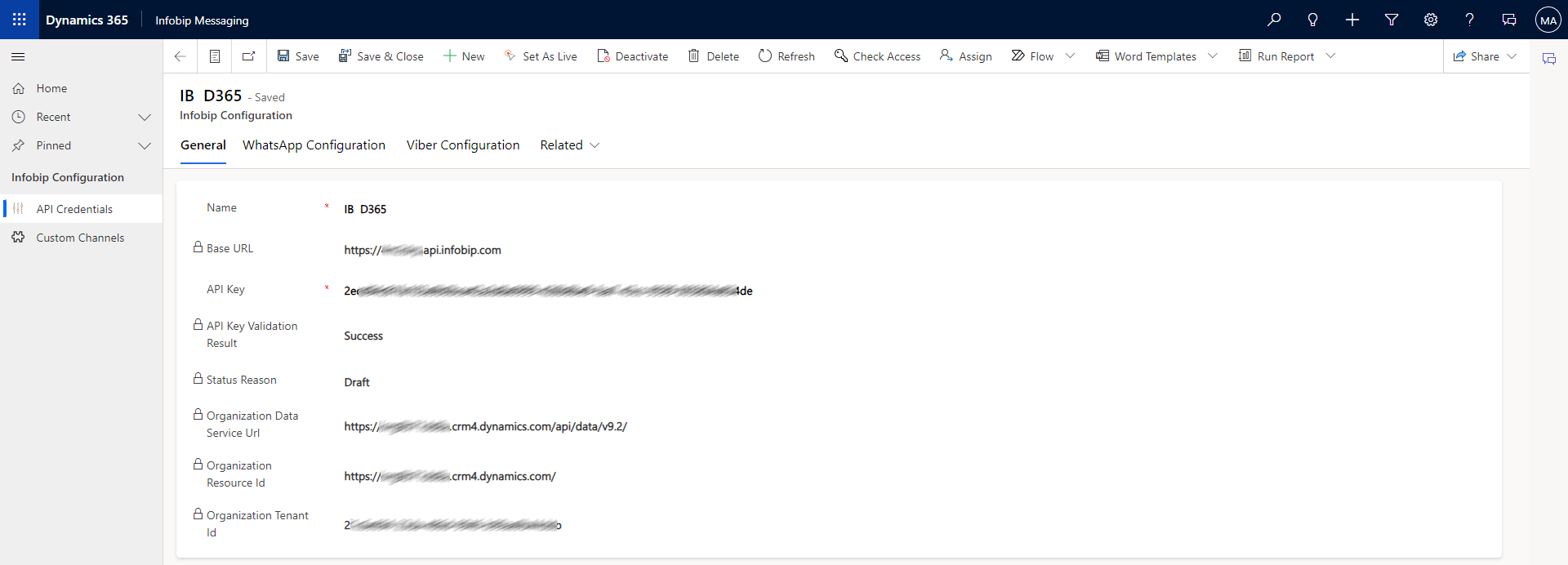
Step 4 - WhatsApp configuration
These steps describe how to configure the WhatsApp channel.
- Go to WhatsApp Configuration.
- Select Yes to enable the WhatsApp channel
- Click Save.
- On the Sender field, you see all the Available senders.
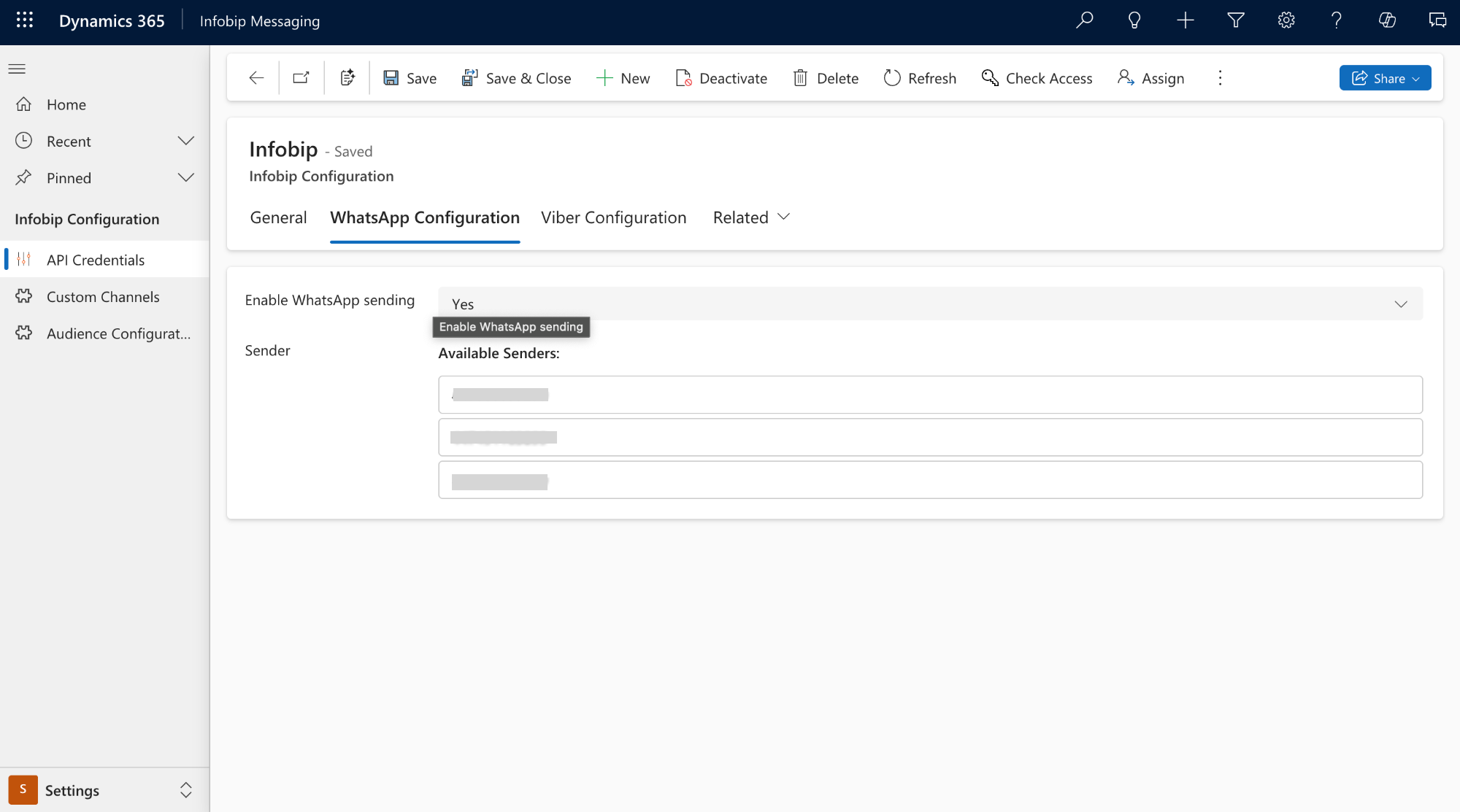
Step 5 - Viber configuration
These steps describe how to configure the Viber channel.
- Go to Viber Configuration.
- Select Yes to enable Viber channel
- On the Sender field, you see all the Available senders.
- On the 1-Way Viber Senders field, you can type name and click Add.
- Click Save.
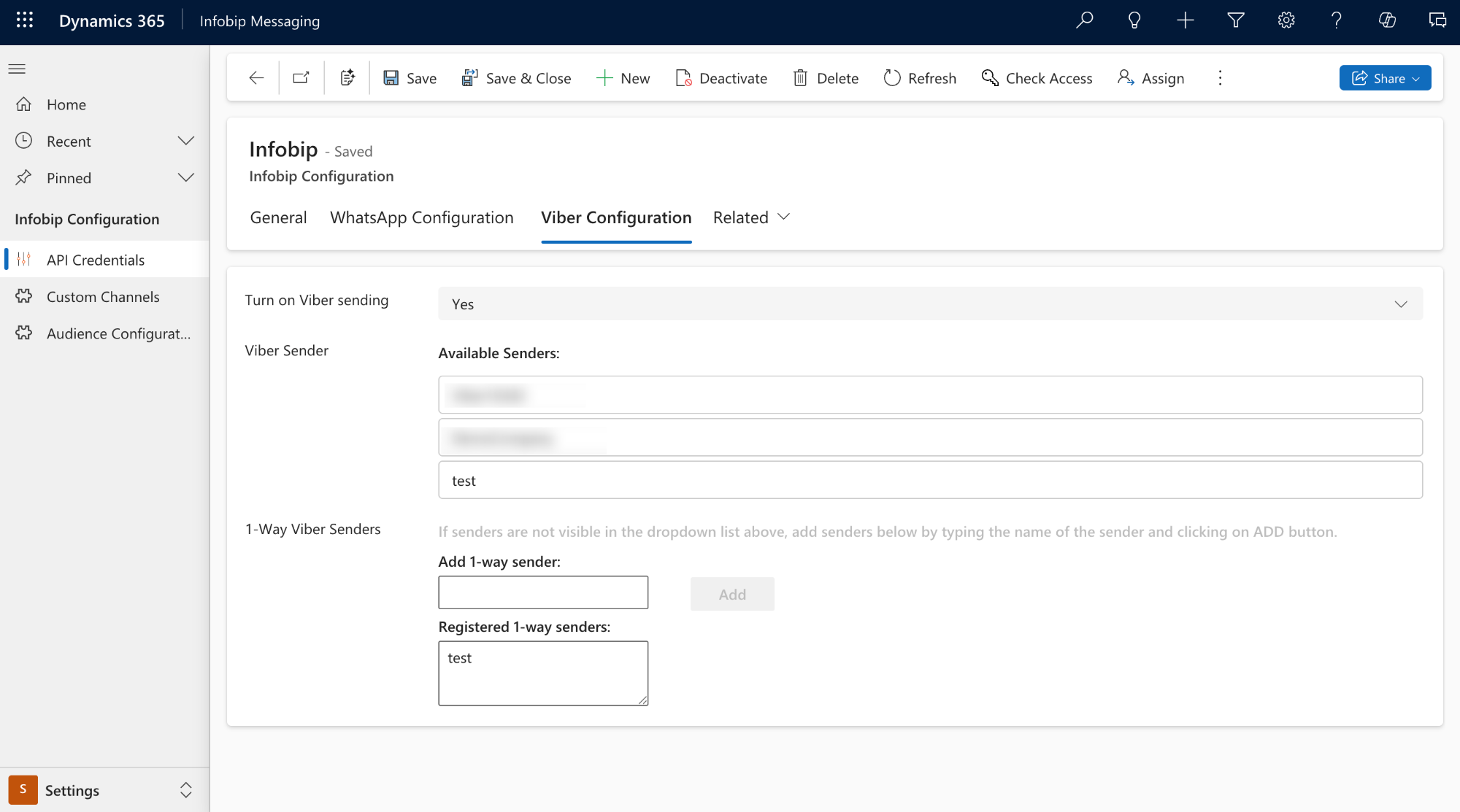
Step 6 - RCS configuration
These step describe how to configure the RCS channel.
- Go to RCS configuration.
- Select Yes to enable the RCS channel.
- On Sender field, you will see all the Available senders.
- On 1-Way RCS Senders field, you can type name and click Add.
- Click Save.
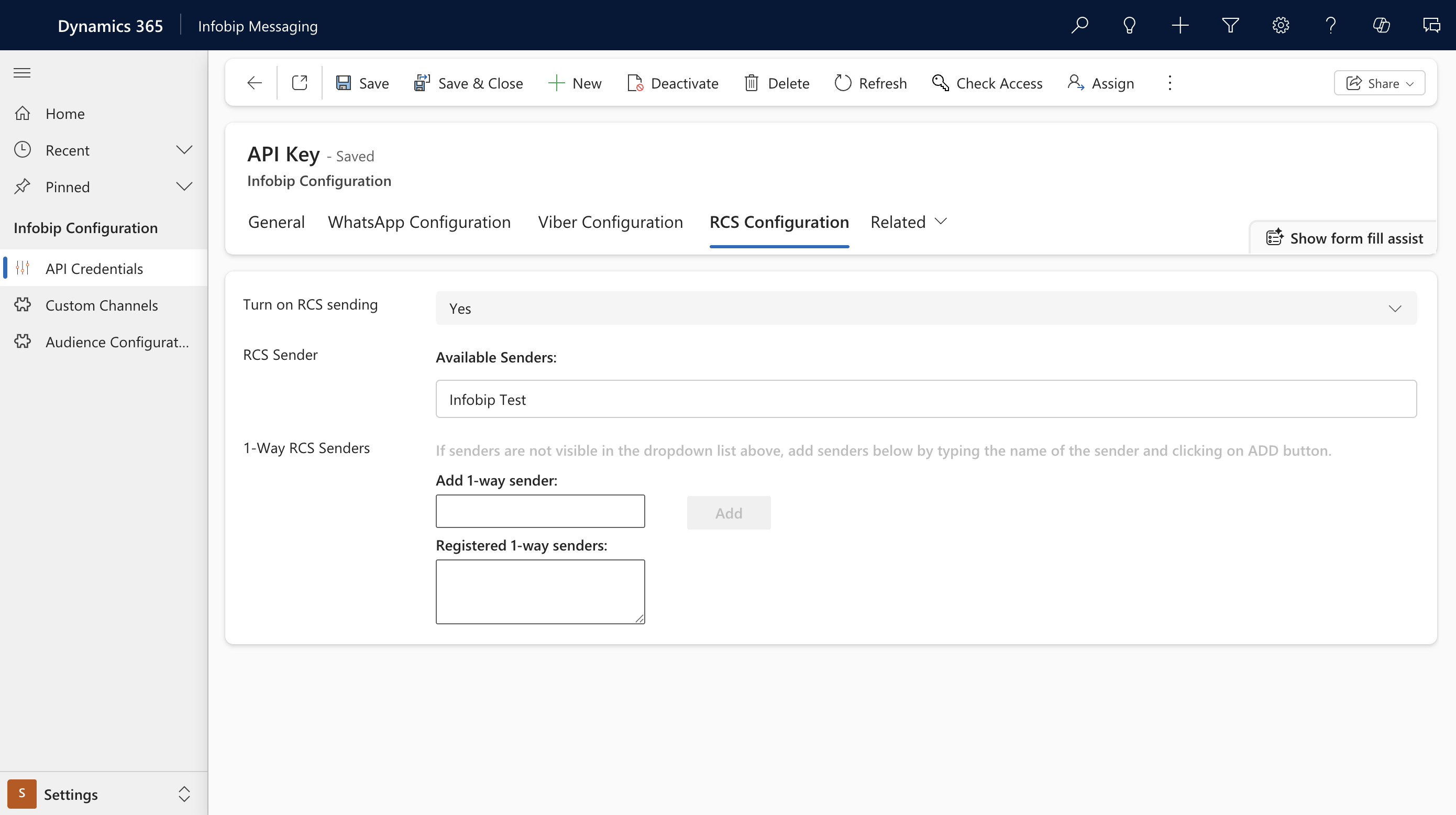
Step 7 - Custom channels configuration
You can configure additional channels. To configure a custom channel:
- Go to Custom Channels and click New custom channel.
- Select the channel that you want to add, and then click Next. This example describes Viber but you can repeat these steps for WhatsApp, if applicable.
- Add a name for the channel in Name. You can also add a description of the channel.
- Add a sender name in Sender. The sender name is displayed in Journey.
- Select the Configuration that you created in Step 2.
- Click Next and then click Done.
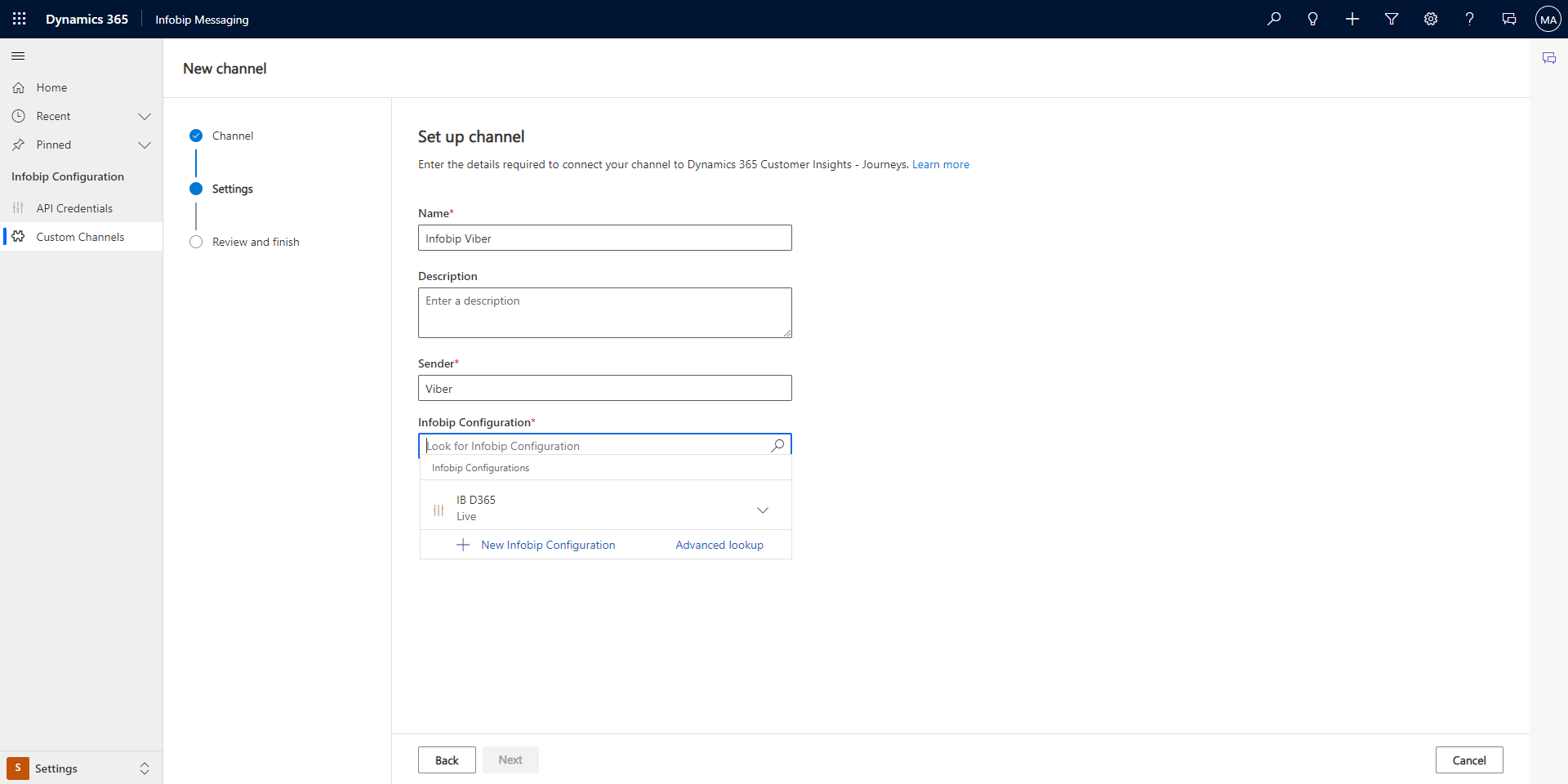
Using the app
When you have installed and configured the app, you can use it to work with contact and leads, segments, add consent to phone numbers, and templates.
Contacts/Leads
Create Contacts and/or Leads with phone numbers set in the fields configured in Step 4 and Step 5. You need to set all fields that will be used as Placeholders.
Segments
Infobip Messaging supports Contact and Lead types of segments.
Create Segments by adding members. Save the segment and click Ready to use on the segment.
Add consent to phone numbers
Add all phone numbers you want to send message to the Active Contact Point Consent.
- Click Consent Center.
- Click Custom consent.
- Add the phone number.
- Select Compliance Profile.
- Select Purpose(this is the same purpose for Journey Message).
- Click Save.
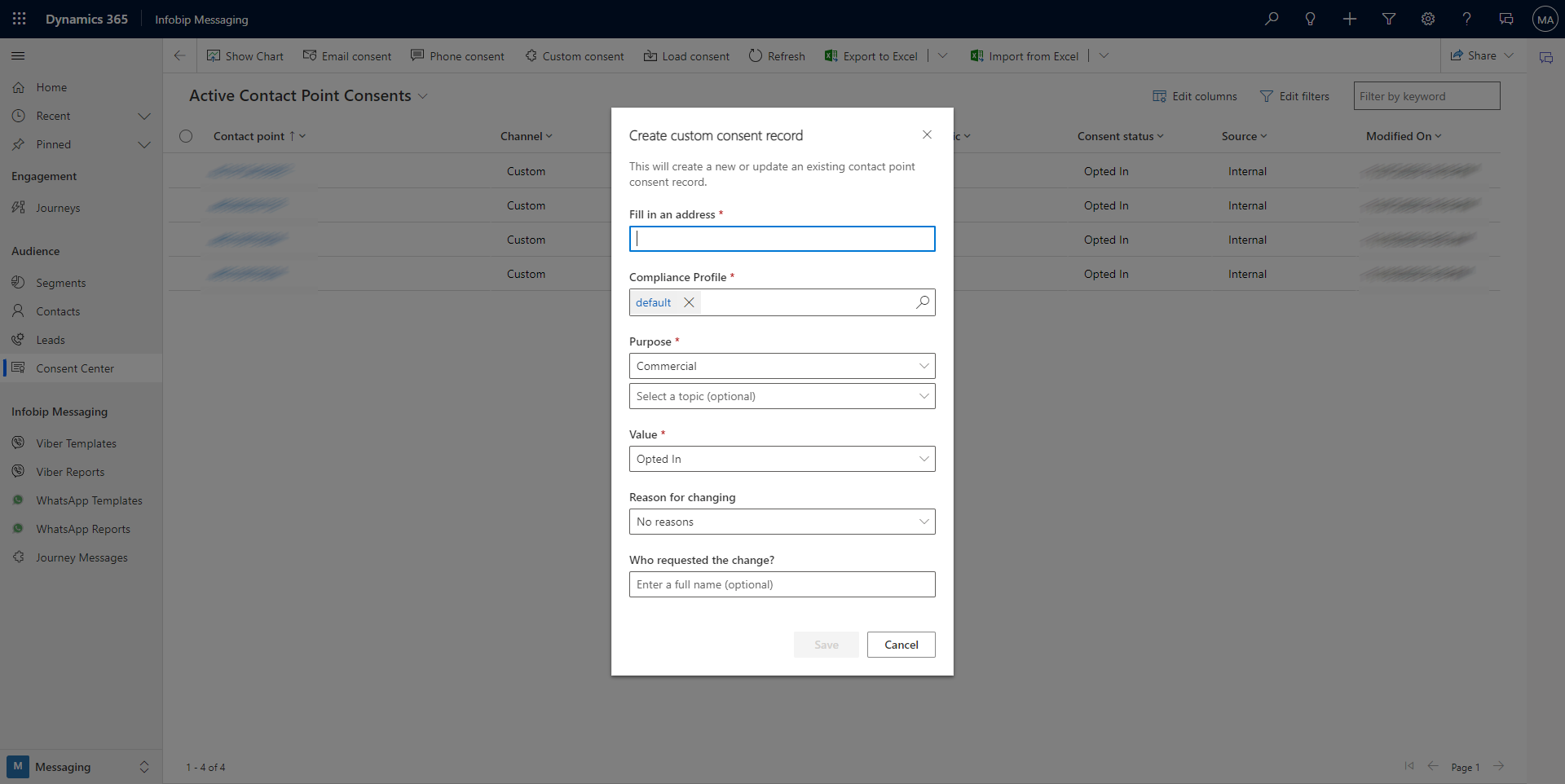
Create templates
Create a Viber template
To create Viber template, use the following steps:
- Click Viber Templates.
- Click New.
- Add a name for the template in Name.
- Select if Placeholders should be taken from the Contact table or Lead table
- Select a Sender from the drop down list.
- Select Add message tags to add Placeholders to the message.
- Compose the message content in Message.
- Click Save.
- Then, click the Go Live button.
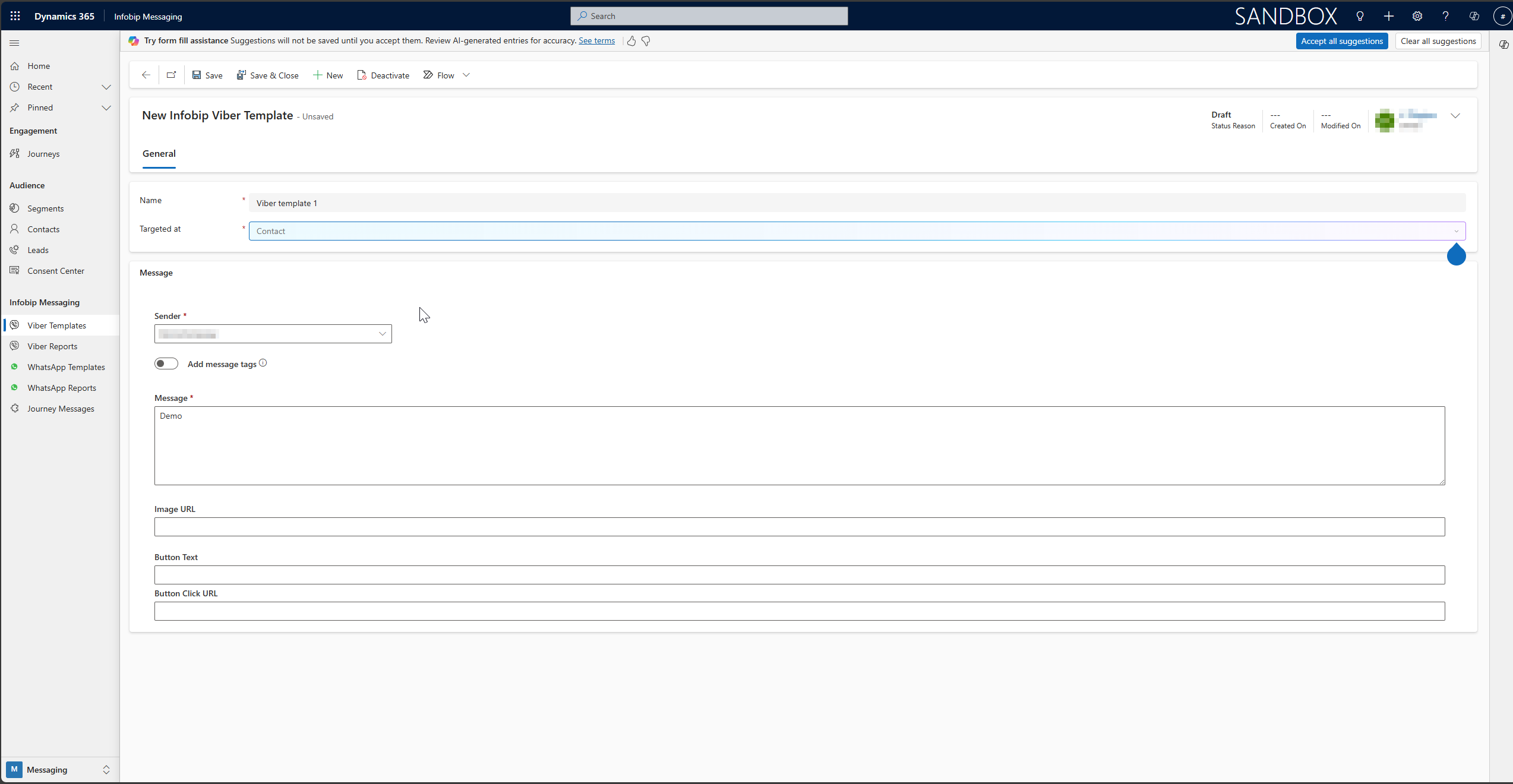
Create a WhatsApp template
To create WhatsApp template, use the following steps:
-
Click WhatsApp Templates.
-
Click New.
-
Add a name for the template in Name.
-
Select if Placeholders should be taken from the Contact table or Lead table.
-
Select a Sender from the drop down list.
-
Select a template from list of templates assigned to selected Sender.
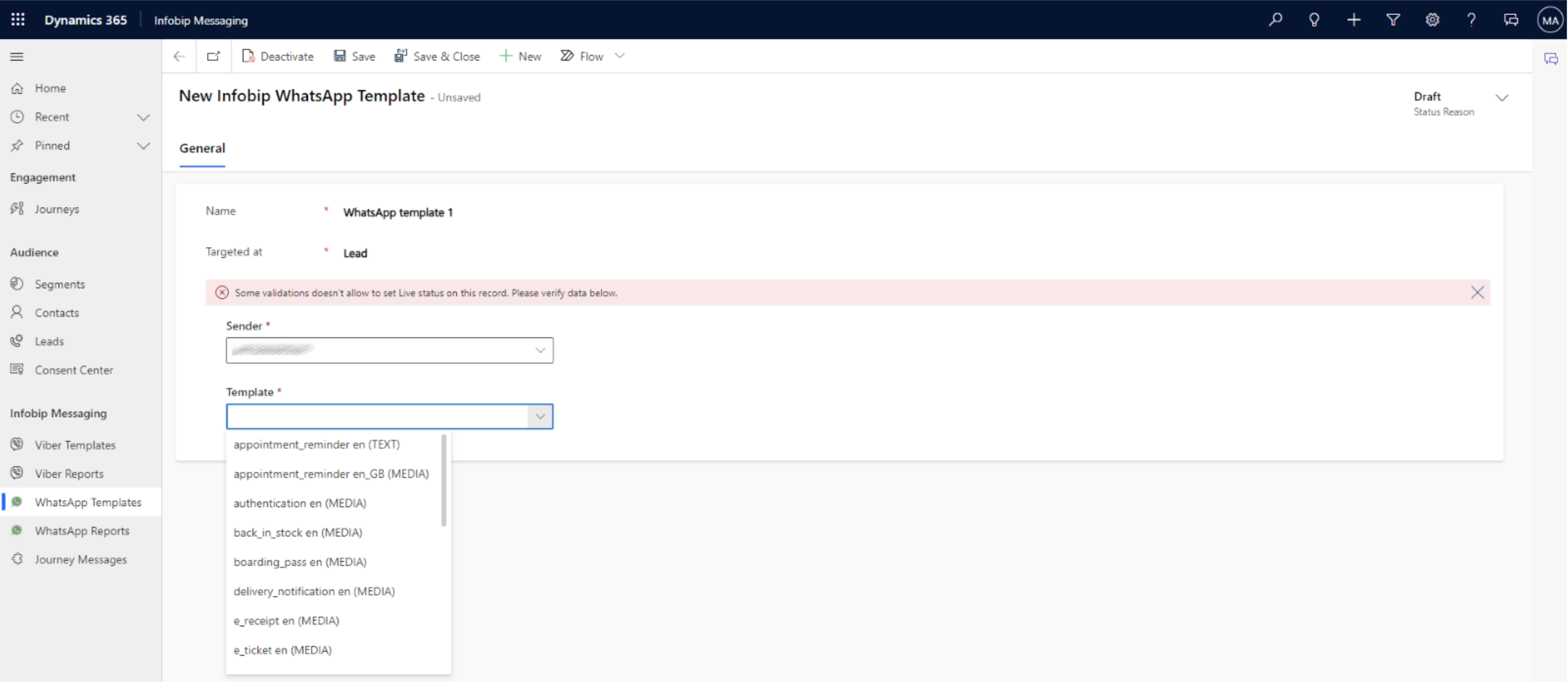
-
Select Add message tags to add Placeholders to the message.
-
In the Body Placeholders field, select which field from Dataverse to input to particular Placeholder.
-
Click Save.
-
Then, click the Go Live button.

Create an RCS template
To create RCS template, use the following steps:
-
Click RCS templates in the left menu.
-
After click, you see list of all templates, click New.
-
On the General tab, fill in the Name for template and choose the audience you want to target.
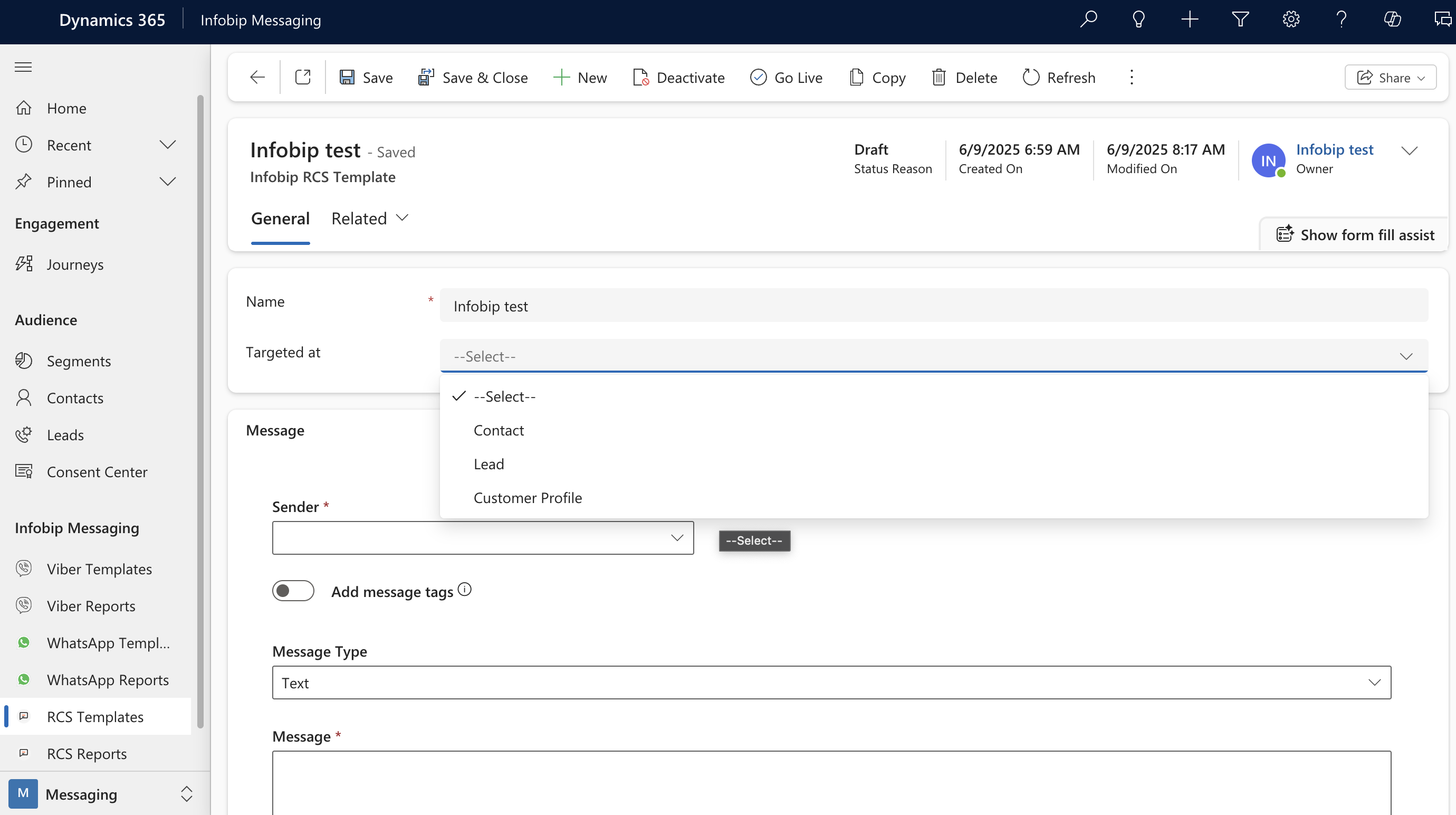
-
Select a Sender from the drop down list.
-
Toggle Add message tags to add Placeholders to the message.
-
Compose the message content in Message.
- You can choose a Message type of either Text, File, Rich Card, or Carousel
- Under each type you can add a suggested action (on Rich Card and Carousel they can also be added as buttons)
-
Click Save.
-
Click Go Live.
Create a Journey Message
To create a Journey Message, you need to embed the created templates:
-
Click Journey Messages, and then New message.
-
Select the channel for the message from drop down list.

-
Add a name in Name.
-
Select a Template from the drop down list.
-
Select Purpose. Make sure that you have added target phone numbers to the Purpose group in the Consent Center.
-
Click Save.
-
Click Test send to test a message. You input the phone number in the next step.
-
Click Ready to send.
Create a Journey
To create a Journey, click Journeys and then click New journey.
-
Add the name of a journey.
-
Select the type of journey. Infobip Messaging supports Trigger-based and Segment-based journey.
-
Select a segment of targets from the drop down list.
-
Set when the journey should be executed.
-
Click Create.
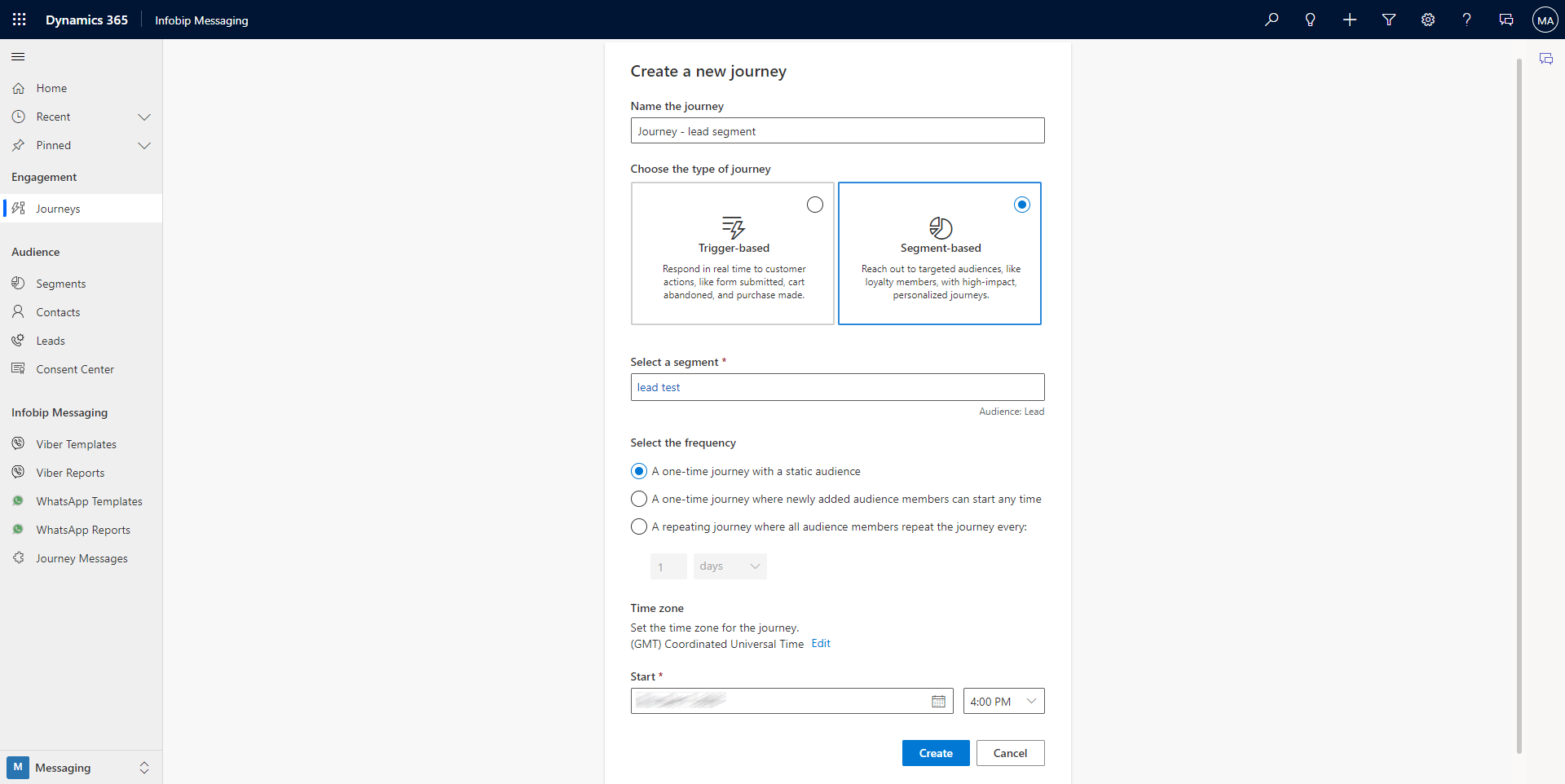
-
On the Add an action or other element window, select Send other types of messages.
-
Select a Channel from the drop down list.
-
Choose a Journey Message from the drop down list. The Journey Messages are available if the particular message is targeted at a Contact or Lead table.
-
Click Save.
-
Click Publish.
The journey target segment type (Contact or Lead) has to be aligned with selected messages types (Contact or Lead). If it is not aligned, error message will be displayed and the journey will not be published.
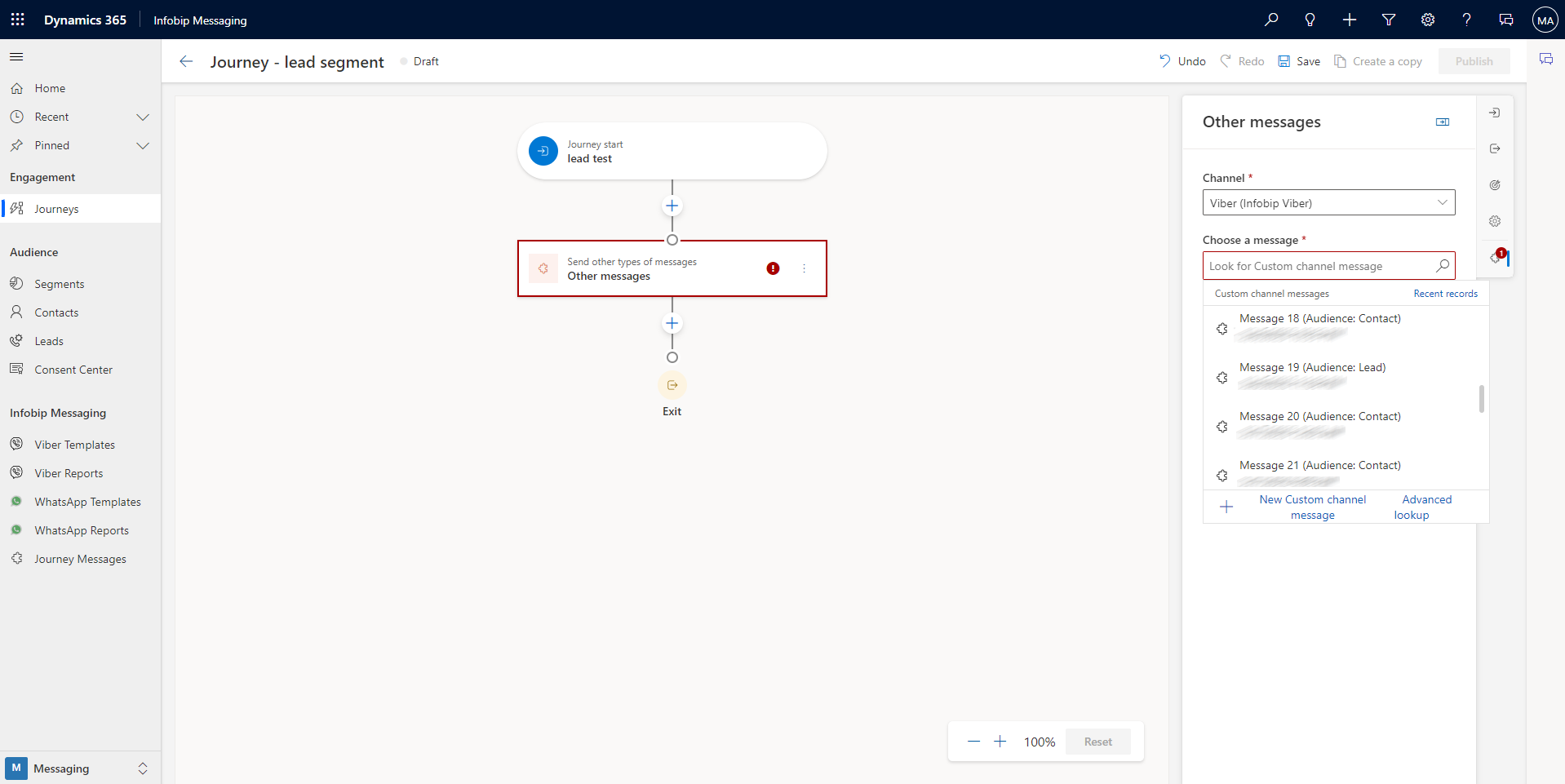
You can check the status of sent messages after selecting it in left menu.